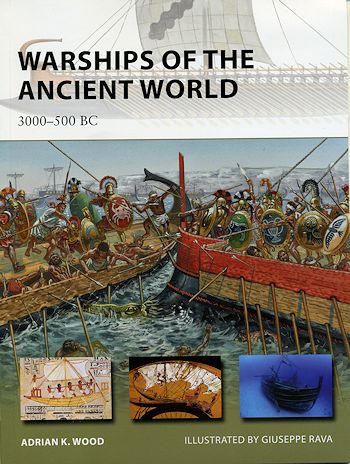 One
rarely thinks of the origins of warships. It was generally thought that they
were basically modifications of standard ships of trade, and that would be
correct. The major purpose of ships in the ancient world was trade and
settlement. Trade to provide wealth for the ship owner and the land of origin,
settlement to carry citizens of overcrowded areas to places they could settle
and expand. Of course, these ships were also useful for carrying soldiers over
great distances, saving them (and the peoples of the land through which they
marched) for any upcoming battles.
One
rarely thinks of the origins of warships. It was generally thought that they
were basically modifications of standard ships of trade, and that would be
correct. The major purpose of ships in the ancient world was trade and
settlement. Trade to provide wealth for the ship owner and the land of origin,
settlement to carry citizens of overcrowded areas to places they could settle
and expand. Of course, these ships were also useful for carrying soldiers over
great distances, saving them (and the peoples of the land through which they
marched) for any upcoming battles.
The Eastern Mediterranean was where major ship use and development
occurred. The Egyptians uses ships on the Nile, while others used them to move
up and down the coat of the Levant from Asia Minor down to Egypt. The Egyptians
rarely sailed too far from home, the Nile being the main waterway. They were
fortunate that the wind generally blew opposite of the Nile's current so heading
upstream was assisted by the wind while the current helped return them to the
delta region. As was the standard of this entire time, oars were used as the
major motive power with the single square sail of ships of the day being only
used as an auxiliary. It was not until centuries after the end of the period
covered by this book that ships were built that used only sails. Egyptian ship
design was initially just local, but later influenced by those of other places.
In addition to the Egyptians, the book covers the Sea People, the
Minoans of Crete, the Syrians and, of course, the Phoenicians, culminating with
the Greeks. Through all of this, we see how ship design grows in terms of
overall design from rather portly cargo vessels to the much sleeker ships of the
Phoenicians and the Greeks. As oars mean speed, we see the numbers and rows of
oars increase. The first decks appear, initially to protect cargo, but later
used to allow soldiers a sure footing. Ships developed rams, often sheathed in
bronze, to sink the enemy's ships. This was not considered the best way to
defeat the enemy as it was preferred that the losing ship be taken as a prize.
Rams were also separate pieces from the rest of the ship so they would not be
damaging to the ship and could be easily repaired.
Author Adrian Wood has done considerable research as he tells the tale
of the development of these vessels from multi-purpose ships until we get the
first purpose built war ships to where carrying stuff was secondary to the
mission. Researching ship design of this time is not an easy task and we have to
grab snippets of information from the writings of the time as well as from what
is presented on pottery as well as any wall paintings or remaining fragments.
However, a cohesive story is told and is one that is fascinating to anyone
interested in the nautical world. Enhanced by images of artifacts and the
excellent illustrations of Giuseppe Rava, we can see how ship development went
forward over the 2500 years covered by this edition.
It is a book that is both fun to read and interesting. A book I enjoyed
reading and I know you will as well.
February 2013
For more on the complete line of Osprey books,
visit www.ospreypublishing.com. In the US, it is
Osprey Direct at 44-02 23rd St, Suite 219, Long Island City, NY 11101., where you can
get a catalogue of available books.
If you would like your product reviewed fairly and quickly, please
contact
me or see other details in the Note to
Contributors.
 One
rarely thinks of the origins of warships. It was generally thought that they
were basically modifications of standard ships of trade, and that would be
correct. The major purpose of ships in the ancient world was trade and
settlement. Trade to provide wealth for the ship owner and the land of origin,
settlement to carry citizens of overcrowded areas to places they could settle
and expand. Of course, these ships were also useful for carrying soldiers over
great distances, saving them (and the peoples of the land through which they
marched) for any upcoming battles.
One
rarely thinks of the origins of warships. It was generally thought that they
were basically modifications of standard ships of trade, and that would be
correct. The major purpose of ships in the ancient world was trade and
settlement. Trade to provide wealth for the ship owner and the land of origin,
settlement to carry citizens of overcrowded areas to places they could settle
and expand. Of course, these ships were also useful for carrying soldiers over
great distances, saving them (and the peoples of the land through which they
marched) for any upcoming battles.